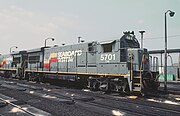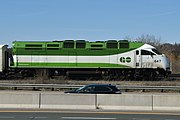
A bogie is a chassis or framework that carries a wheelset, attached to a vehicle—a modular subassembly of wheels and axles. Bogies take various forms in various modes of transport. A bogie may remain normally attached or be quickly detachable ; it may contain a suspension within it, or be solid and in turn be suspended ; it may be mounted on a swivel, as traditionally on a railway carriage or locomotive, additionally jointed and sprung, or held in place by other means.
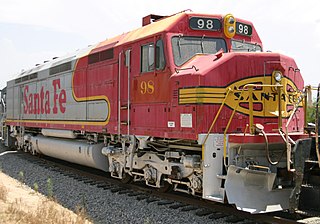
A cowl unit is a body style of diesel locomotive. The terminology is a North American one, though similar locomotives exist elsewhere. A cowl unit is one with full-width enclosing bodywork, similar to the cab unit style of earlier locomotives, but unlike the cab unit style, the bodywork is merely a casing and is not load-bearing. All the strength is in the locomotive's frame, beneath the floor, rather than the bridge-truss load-bearing carbody of the earlier type.
The AAR wheel arrangement system is a method of classifying locomotive wheel arrangements that was developed by the Association of American Railroads. It is essentially a simplification of the European UIC classification, and it is widely used in North America to describe diesel and electric locomotives. It is not used for steam locomotives which use the Whyte notation instead.
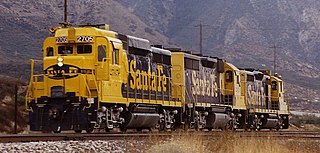
The EMD GP30 is a 2,250 hp (1,680 kW) four-axle road switcher diesel-electric locomotive built by General Motors Electro-Motive Division of La Grange, Illinois between July 1961 and November 1963. A total of 948 units were built for railroads in the United States and Canada, including 40 cabless B units for the Union Pacific Railroad.

EMD E-units were a line of passenger train diesel locomotives built by the General Motors Electro-Motive Division (EMD) and its predecessor the Electro-Motive Corporation (EMC). Final assembly for all E-units was in La Grange, Illinois. Production ran from May 1937, to December, 1963. The name E-units refers to the model numbers given to each successive type, which all began with E. The E originally stood for eighteen hundred horsepower, the power of the earliest model, but the letter was kept for later models of higher power.

EMD F-units were a line of diesel-electric locomotives produced between November 1939 and November 1960 by General Motors Electro-Motive Division and General Motors-Diesel Division. Final assembly for all F-units was at the GM-EMD plant at La Grange, Illinois, and the GMDD plant in London, Ontario, Canada. They were sold to railroads throughout the United States, Canada, Mexico and a few were exported to Saudi Arabia. The term F-unit refers to the model numbers given to each successive type, all of which began with the letter F. The "F" originally meant Fourteen, as in 1,400 horsepower (1,000 kW), not F as in Freight. Longer EMD E-units for passenger service had twin 900-horsepower (670 kW) diesel engines. The "E" meant Eighteen as in 1,800 horsepower (1,300 kW). Similarly, for early model EMD switchers, "S" meant Six hundred and "N" meant Nine hundred horsepower.

A hood unit, in North American railroad terminology, is a body style for diesel and electric locomotives. On a hood unit, the body of the locomotive is less than full-width for most of the locomotive's length, with walkways on the outside of the locomotive. In contrast, a cab unit has a full-width carbody for the length of the locomotive. A hood unit has sufficient visibility to be operated in both directions from a single cab. Also, the underframe is the main load-bearing member, allowing the hood to be non-structural and easily opened or even removed for maintenance.

The EMD Dash 2 is a line of diesel-electric locomotives introduced by General Motors' Electro-Motive Division (EMD) on January 1, 1972. Designations of these models were those of the former models with "-2" added. They retained the basic specifications of the earlier models in terms of power output and most other features, but introduced a number of improvements to the locomotives' internal systems, specifically the electrical systems. These were intended to improve availability, efficiency, and ease of maintenance.

The EMD MP15, sometimes referenced as MP15DC is a 1,500 hp (1,100 kW) switcher-type diesel locomotive model produced by General Motors' Electro-Motive Division between 1974-1980. It was equipped with an engine having a roots blower. The length was either 47' 8" or 48' 8" depending on the build date.

The EMD GP15-1 is a 4-axle switcher diesel-electric locomotive built by General Motors Electro-Motive Division between June 1976 and March 1982. Intended to provide an alternative to the rebuilding programs that many railroads were applying to their early road switchers, it is generally employed as a yard switcher or light road switcher. This locomotive is powered by a 12-cylinder EMD 645E engine, which generates 1,500 hp (1,119 kW). The GP15-1 uses a 50-foot-9-inch (15.47 m) frame, has a wheelbase of 29 ft 9 in (9.07 m) and has a length over couplers of 54 ft 11 in (16.74 m). A total of 310 units were built for American railroads. A number of GP15-1s remain in service today for yard work and light road duty. The radiator section is similar to those found on the EMD SD40T-2 and EMD SD45T-2 "tunnel motors," leading some observers to incorrectly identify the units as such or as GP15Ts, and giving them the nickname "baby tunnel motors".

The "Beep" is an individual switcher locomotive built in 1970 by the Atchison, Topeka and Santa Fe Railway at its Cleburne, Texas, workshops. Technically a rebuild, the Beep originally entered service on the Santa Fe as a Baldwin Model VO-1000. Following its successful CF7 capital rebuilding program, the company hoped to determine if remanufacturing its aging, non-EMD end cab switchers by fitting them with new EMD prime movers was an economically viable proposition. The conversion procedure proved too costly and only the one unit was modified. In 2008-2009, this locomotive was retired and stored operational at Topeka, Kansas. In May 2009 the unit was donated to the Western America Railroad Museum in Barstow, California.

The EMD GP16 are a series of rebuilt road switcher diesel-electric locomotives, a result of a remanufacturing program initiated by the Seaboard Coast Line Railroad (SCL) in an effort to spare the cost of purchasing new motive power in the late 1970s. This involved the rebuilding of their aging fleet of EMD GP7, GP9, and GP18 road switchers. 155 locomotives were rebuilt by the SCL.
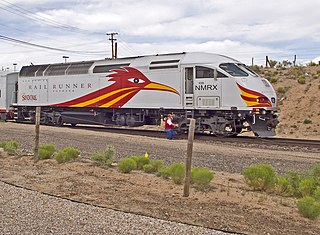
MPXpress is a series of diesel-electric passenger train locomotives designed for commuter rail service. The locomotives are built by MotivePower, a subsidiary of Wabtec. To date, MPI has offered five main variants: MP36PH-3S, MP36PH-3C, MP40PH-3C, MP32PH-Q, and MP54AC. However, due to federal emissions standards, the MP54AC is the only locomotive currently for sale in the United States, as it is the only MPXpress locomotive that meets Tier 4 standards.

The EMD 567 is a line of large medium-speed diesel engines built by General Motors' Electro-Motive Division. This engine, which succeeded Winton's 201A, was used in EMD's locomotives from 1938 until its replacement in 1966 by the EMD 645. It has a bore of 8 1⁄2 in (216 mm), a stroke of 10 in (254 mm) and a displacement of 567 cu in (9.29 L) per cylinder. Like the Winton 201A, the EMD 645 and the EMD 710, the EMD 567 is a two-stroke engine.
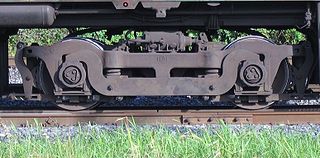
AAR Type A trucks were first introduced with EMD locomotives sold in 1935; they were a success, became standard on EMD switchers into the 1970s, and were also used on various other makers' locomotives. Their initial design was a collaboration between Martin P Blomberg at EMD and the originating foundry General Steel Industries. Intended for industrial plant and rail yard shunting duty, this truck has a basic suspension system with drop equalizers, secondary leaf springs and primary coil springs, which provide adequate damping and relatively simplified maintenance. It does not have swing hangers as may be seen in higher-speed designs such as the Blomberg B.
Martin Petrus Frederik Blomberg was an American engineer of Swedish origin. He became well known for the development of the truck frame for the diesel-electric locomotives of the Electro Motive Division (EMD).

The EMD G22 Series were first introduced in 1968 to replace the popular G12 along with various improvements. They carried a low per axle weight on their Flexicoil Type-GC trucks and were the first model series to have a low nose as a standard option as well.

The EMD GT22 Series were first introduced in 1972 after the rise in popularity of six axle locomotives. The GT series now carried a turbocharger that increased the horsepower depending on customer input. The GT series also utilized six axle HTC Trucks, which allowed the locomotive to haul heavier loads at slower speeds with minimal wheelslip.

The Brookville BL36PH is a four-axle diesel-electric locomotive for commuter trains, designed by Brookville Equipment Corporation. It is built with an MTU 20V4000 V20 engine rated at 3,619 horsepower (2,699 kW) to meet EPA Tier 3 emissions standards. It was the first North American passenger locomotive designed with a 20-cylinder engine since the EMD SDP45 and EMD FP45, originally built in the 1960s. Head end power is generated by a separate, smaller diesel gen-set and is rated at 500 kW (670 hp). The outer shell of the locomotive has been designed by Cesar Vergara, who has also designed the outer shells of several other North American passenger locomotives, including the MPI MPXpress, the GE Genesis, the MPI HSP46 and the EMD F59PHI.

The EMD GT26 Locomotive Series made their debut in 1967 after the rise in popularity of the American EMD SD40. Designed to meet most First World, Second World and Third World countries, the GT26 Series were now equipped with a turbocharged high horsepower EMD 645 Series engine as well as six axle HT-C trucks to provide better traction effort at slow speeds. Based on customer input, the GT26 Series would be defined by various designations that suit the customer's railway operations.


